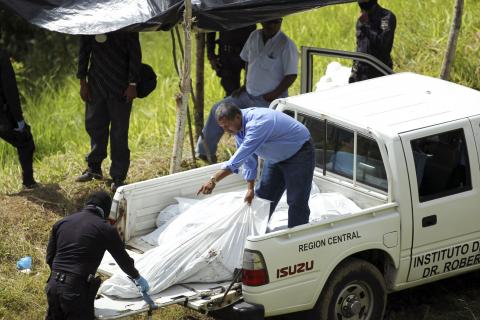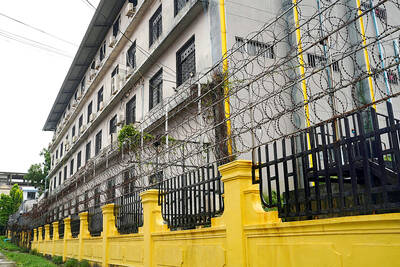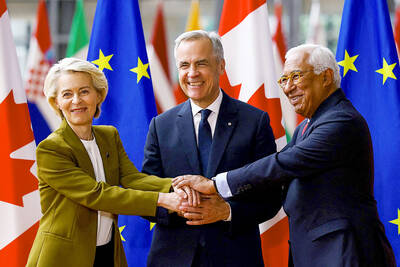Victor Garcia, alias “The Duck,” at 39 has survived longer than most gang members in El Salvador, and has seen hundreds of his “homies” killed by rivals over the years.
The relentless tit-for-tat murders between El Salvador’s two largest street gangs — Calle 18 and Mara Salvatrucha — made the country the most murderous in the world last year after neighboring Honduras, also ravaged by gang violence.
That was until Garcia, from the Calle 18 (“18th Street”) gang, along with elders from the Mara Salvatrucha declared an unprecedented truce that authorities say has cut the homicide rate in half in just four months.

Photo: Reuters
“We’ve been through things that have changed us. It is a waste of life, those who have died in this conflict,” said Garcia, a tattoo of a skeleton hand clutching his shaved head.
Formed in the 1980s in the US by Central American immigrants, many refugees from the region’s civil wars, the gangs or maras grew into an international franchise when criminals were deported back home.
They have grown dramatically in the last two decades and El Salvador alone has an estimated 64,000 gang members. Branches operate across Central America and in at least 42 states in the US.
The gangs deal drugs, run prostitution rings and protection rackets and carry out armed robberies. Many gang members cover their faces and bodies with menacing tattoos to prove their lifelong commitment. The turf wars are brutal, with gangs often targeting their rivals’ family members.
Tired of the cycle of revenge killings, gang leaders housed side-by-side with their enemies in a maximum security prison outside the capital of San Salvador decided to broker a deal.
Garcia from the Calle 18 gang and Aristides Umanzor, aka “El Sirra,” from the Mara Salvatrucha — each backed up by 15 of their top lieutenants — sought out a Catholic bishop and a former leftist congressman to serve as mediators.
In March, they surprised the country by releasing a joint statement declaring an end to violence and pledging to freeze recruitment of new adolescent members, especially in poor neighborhoods and around schools.
Since then, the change has been dramatic. Murder rates are down to around five a day from more than a dozen before the pact. On April 14, El Salvador recorded its first day in three years without a single murder.
“We aren’t demobilizing, we’ll always be gangsters,” Garcia said from a prison in Quezaltepeque where he is serving out a 28-year sentence. “But we are quitting crime little by little as long as we can find jobs and a chance to re-enter society.”
Salvadorean President Mauricio Funes, a leftist, insists his government did not cut any deals with the gangsters, but shortly before the truce was made public, 30 top gang leaders were transferred from maximum-security prisons to others with benefits like family visits. Garcia was transferred to Quezaltepeque, where prisoners enjoy some modest freedoms, although he still lives with 15 other men in a cell designed for six.
The government has lauded the truce and is trying to help its long-term success by working with business leaders to offer work and rehabilitation programs for gang members.
It is a policy U-turn from the “iron fist” tactics used against the gangs for years in Central America. Under Funes’ conservative predecessor, teenagers could be arrested just for sporting gang tattoos without having committed any crime, filling the jails to dangerous levels.
“It was open hunting season on the gangs. We knew that if we didn’t do something soon, this was never going to change,” Garcia said.
El Faro, an online newspaper in El Salvador, reported the truce was the result of a government deal with gangsters to stop the violence in exchange for better prison conditions and other favors, but the government denies that.
Still, it hopes that, just as the rivalries crossed borders for decades, the message of peace from Garcia and his former enemies can now seep over to neighboring countries.
“We want to share our experiences because we are seeing results,” said Salvadorean Minister of National Defense David Munguia, who recently met with his counterparts in Guatemala and Honduras to discuss regional crime-fighting strategies. “We would like it to be replicated elsewhere, but always considering the specific circumstances in the different countries.”

Drug lord Jose Adolfo Macias Villamar, alias “Fito,” was Ecuador’s most-wanted fugitive before his arrest on Wednesday, more than a year after he escaped prison from where he commanded the country’s leading criminal gang. The former taxi driver turned crime boss became the prime target of law enforcement early last year after escaping from a prison in the southwestern port of Guayaquil. Ecuadoran President Daniel Noboa’s government released “wanted” posters with images of his face and offered US$1 million for information leading to his capture. In a country plagued by crime, members of Fito’s gang, Los Choneros, have responded with violence, using car

CYBERCRIME, TRAFFICKING: A ‘pattern of state failures’ allowed the billion-dollar industry to flourish, including failures to investigate human rights abuses, it said Human rights group Amnesty International yesterday accused Cambodia’s government of “deliberately ignoring” abuses by cybercrime gangs that have trafficked people from across the world, including children, into slavery at brutal scam compounds. The London-based group said in a report that it had identified 53 scam centers and dozens more suspected sites across the country, including in the Southeast Asian nation’s capital, Phnom Penh. The prison-like compounds were ringed by high fences with razor wire, guarded by armed men and staffed by trafficking victims forced to defraud people across the globe, with those inside subjected to punishments including shocks from electric batons, confinement

The team behind the long-awaited Vera Rubin Observatory in Chile yesterday published their first images, revealing breathtaking views of star-forming regions as well as distant galaxies. More than two decades in the making, the giant US-funded telescope sits perched at the summit of Cerro Pachon in central Chile, where dark skies and dry air provide ideal conditions for observing the cosmos. One of the debut images is a composite of 678 exposures taken over just seven hours, capturing the Trifid Nebula and the Lagoon Nebula — both several thousand light-years from Earth — glowing in vivid pinks against orange-red backdrops. The new image

Canada and the EU on Monday signed a defense and security pact as the transatlantic partners seek to better confront Russia, with worries over Washington’s reliability under US President Donald Trump. The deal was announced after a summit in Brussels between Canadian Prime Minister Mark Carney and European Commission President Ursula von der Leyen and European Council President Antonio Costa. “While NATO remains the cornerstone of our collective defense, this partnership will allow us to strengthen our preparedness ... to invest more and to invest smarter,” Costa told a news conference. “It opens new opportunities for companies on both sides of the